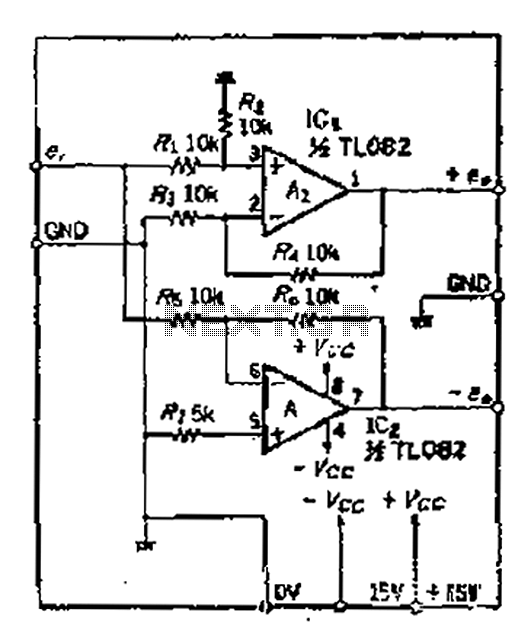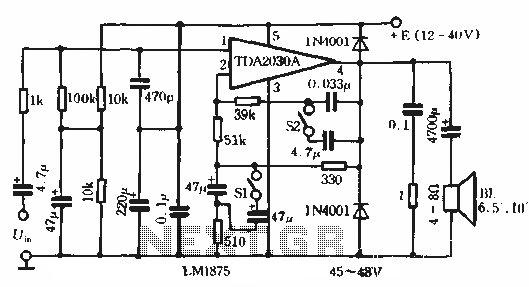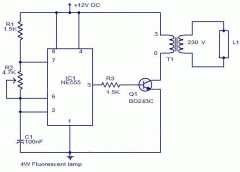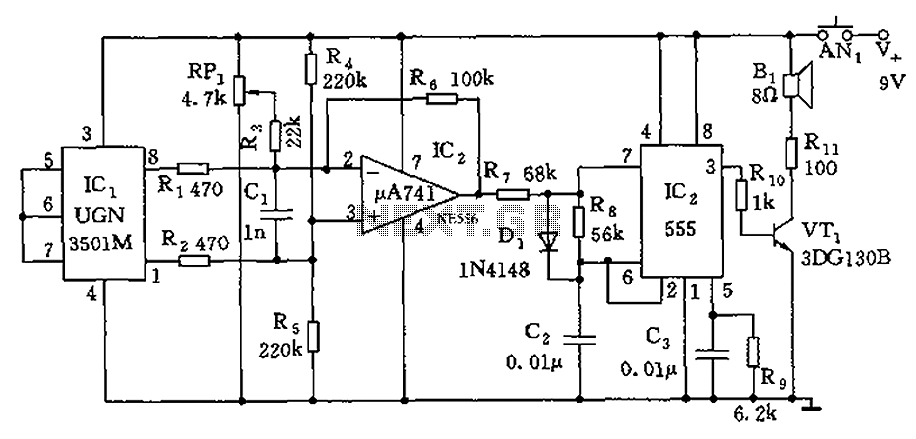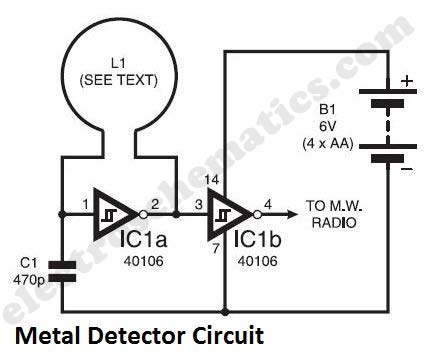
AN6610 Application Circuit
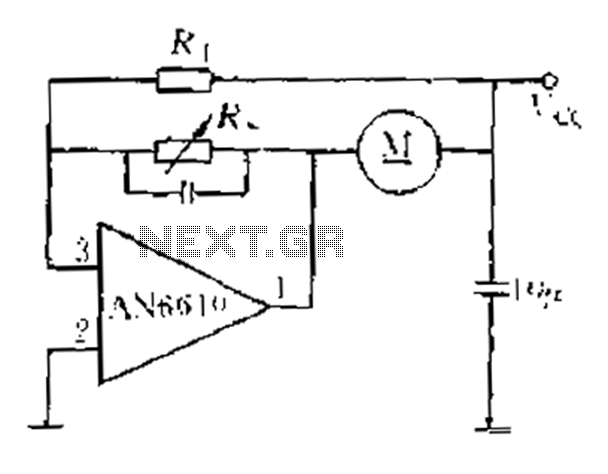
AN6610 Application Circuit operates as follows: When the supply voltage (Vcc) changes due to mechanical load variations, it can affect the motor speed. The motor speed is proportional to the back electromotive force (EMF). Consequently, the voltage across the motor also changes. An adjustable resistor (R1, R4) samples the voltage, reflecting these changes, and delivers the information to the inverting input terminal of the error amplifier. This voltage is compared with the reference voltage (VREF) at the inverting input. The error amplifier adjusts the base of the transistor, controlling the output voltage at pin 3. There is an inverse relationship between the output voltage and the feedback control, resulting in a closed-loop control system that maintains a constant motor speed.
The AN6610 application circuit is designed for precise motor speed regulation in response to variations in supply voltage and mechanical load. The circuit utilizes feedback control to ensure that the motor operates at a consistent speed, despite external disturbances.
The operation begins with the detection of changes in the supply voltage (Vcc) which can occur due to fluctuations in the mechanical load applied to the motor. These changes lead to variations in the back EMF generated by the motor, which directly influences the motor speed.
To monitor these variations, the circuit employs an adjustable resistor network (R1, R4) that samples the voltage across the motor. This sampled voltage is crucial as it reflects the instantaneous operating conditions of the motor. The error amplifier receives this sampled voltage at its inverting input and compares it with a predetermined reference voltage (VREF) at the inverting input.
The difference between these two voltages generates an error signal, which is processed by the error amplifier. The output of the error amplifier is connected to the base of a transistor that acts as a control element for the motor's supply voltage. By adjusting the base current of the transistor, the output voltage at pin 3 is modulated, allowing for real-time adjustments to the motor's operating conditions.
The feedback mechanism established in this circuit creates a negative feedback loop that stabilizes the motor speed. When the motor speed deviates from the desired setpoint, the error amplifier responds by altering the output voltage, thus correcting the speed. This closed-loop control system is essential for applications requiring precise motor control, ensuring that the motor maintains a consistent performance under varying load conditions.
Overall, the AN6610 application circuit provides an effective solution for motor speed control, leveraging the principles of feedback and error amplification to achieve reliable and stable operation.AN6610 Application Circuit It works briefly as follows: When the supply voltage vcc motor mechanical or negative change when the load changes, can cause changes in motor speed. And speed proportional to the anti-electric potential E. Marrow also change accordingly the voltage across the motor also changes. From adjustable resistor 1, 4 on two sampled voltage v ,. Reflects these voltage changes, delivered to the error amplifier inverting input terminal, compare it with the inverting input of the reference voltage VREF, the error amplifier controls the two rear base of the transistor, the output voltage (pin 3) is adjusted. 3-pin output voltage and V.. There was a negative relationship between the feedback control, the results tend to be closed-loop control to maintain a constant speed.
The AN6610 application circuit is designed for precise motor speed regulation in response to variations in supply voltage and mechanical load. The circuit utilizes feedback control to ensure that the motor operates at a consistent speed, despite external disturbances.
The operation begins with the detection of changes in the supply voltage (Vcc) which can occur due to fluctuations in the mechanical load applied to the motor. These changes lead to variations in the back EMF generated by the motor, which directly influences the motor speed.
To monitor these variations, the circuit employs an adjustable resistor network (R1, R4) that samples the voltage across the motor. This sampled voltage is crucial as it reflects the instantaneous operating conditions of the motor. The error amplifier receives this sampled voltage at its inverting input and compares it with a predetermined reference voltage (VREF) at the inverting input.
The difference between these two voltages generates an error signal, which is processed by the error amplifier. The output of the error amplifier is connected to the base of a transistor that acts as a control element for the motor's supply voltage. By adjusting the base current of the transistor, the output voltage at pin 3 is modulated, allowing for real-time adjustments to the motor's operating conditions.
The feedback mechanism established in this circuit creates a negative feedback loop that stabilizes the motor speed. When the motor speed deviates from the desired setpoint, the error amplifier responds by altering the output voltage, thus correcting the speed. This closed-loop control system is essential for applications requiring precise motor control, ensuring that the motor maintains a consistent performance under varying load conditions.
Overall, the AN6610 application circuit provides an effective solution for motor speed control, leveraging the principles of feedback and error amplification to achieve reliable and stable operation.AN6610 Application Circuit It works briefly as follows: When the supply voltage vcc motor mechanical or negative change when the load changes, can cause changes in motor speed. And speed proportional to the anti-electric potential E. Marrow also change accordingly the voltage across the motor also changes. From adjustable resistor 1, 4 on two sampled voltage v ,. Reflects these voltage changes, delivered to the error amplifier inverting input terminal, compare it with the inverting input of the reference voltage VREF, the error amplifier controls the two rear base of the transistor, the output voltage (pin 3) is adjusted. 3-pin output voltage and V.. There was a negative relationship between the feedback control, the results tend to be closed-loop control to maintain a constant speed.
